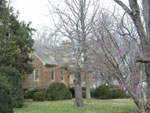BROWSE BY CATEGORY
- Archives and Libraries
- Blogs and Networking
- Bookmark This
- Digital Tools
- Examples of Teaching
- Exhibits
- Film Reviews
- History and Headlines
- Historic Sites and Museums
- Historical Thinking
- Holidays and Heritage
- Issues and Research
- Lesson Plans
- Material and Visual Culture
- Multimedia
- Organizations and Agencies
- Primary Sources
- Professional Development
- Publications
- Student Activities
- Teaching Materials
- Websites
Jennifer Orr on Experiencing History: A Visit to the Parson Weems House
 ,
, 
Recently I had the opportunity to visit a privately owned historic home with my family. The home is not far from where we live. It was owned in the late 1700s by Parson Mason Weems. He is known for being the first biographer of George Washington, and the creator of the story of young George chopping down the cherry tree.
Based on my anecdotal research, I would say that this well-known story is not as widely believed to be true as it was a decade ago. However, having spent a fair bit of time explaining to people that George did not chop down a cherry tree and claim to be unable to tell a lie, Parson Weems has never been one of my favorite historical figures.
In spite of that, as soon as we received the information about the open house I knew we had to go. It was a once in a lifetime experience. The house alone made our visit worthwhile. It was built in 1740 on the foundation of a fort that had been there previously. The kitchen is downstairs and includes the original, large space with a fireplace so huge it could hold a double bed. The modern kitchen is attached. The master bedroom’s floor slopes at what must be at least a 15-degree angle.

A fireplace in the Weems house
Visiting with my husband, the historian, was quite helpful. Each bedroom had a small door beneath a window with a label, ‘fire rope.’ He was able to explain the purpose: behind each door was a rope tied securely for escaping out through the window in case of a fire. He also helped me understand the changes made in the house over the years as it was modernized. Much of the furniture and furnishings were quite old, if not dating back to Parson Weems’s time. Looking at the secretaries (a type of writing desk), with all their nooks and crannies was an interesting view into the past. For other pieces we were unable to determine the purpose, in spite of some later research.
Talking with our daughters, ages eight and five, about the house and its most famous owner as we walked the halls where he once walked and stood in the room in which George and Martha Washington stayed on their honeymoon trip to Mount Vernon, I found myself thinking very differently about Parson Weems. Surprisingly I was putting him in a clearer historical context and feeling a personal connection to him.
I began to think more about why he wrote his biography of George Washington in the way he did. Today such a biography would be discredited and seen as shameful. Two hundred years ago it was different. The question of accuracy was not viewed in the same way it is today. Stories told for the purpose of sharing a moral were widely used and accepted.
It has been several weeks since we visited Parson Weems’ home and I am still thinking of it frequently. We’ve done some research and reading about Weems and the area in which he lived. I now have a much better understanding of his time period and his life than I did before our visit.
Experiencing history as a learner rather than as the teacher was a wonderful opportunity. Asking questions, genuinely wondering what something meant or who someone was or why something happened and learning the answers, or not, was exciting. It was a reminder of what history can be for students if we can make it real, meaningful, and relevant for them.
For more information
Visiting the homes of historical figures can help anyone, teacher or student, better understand what life was like in the past. Eighth-grade teacher Elizabeth Schaefer also wrote for Teachinghistory.org's blog about the inspiration she gained from visiting a house. Read her thoughts on Lincoln's Cottage!
Another way to learn from historic sites is to volunteer at them. High school teacher Roseanne Lichatin suggests resources and guidelines for encouraging older students to volunteer.
Not certain where to start uncovering local history? Teachinghistory.org's Daisy Martin suggests places to start looking. High school teacher Jack Schneider also shares ideas.
High school teacher James A. Percoco explains how his students become student historians as they guide the class through visits to Gettysburg and other locations.
